Domestic canary
| Canary | |
|---|---|
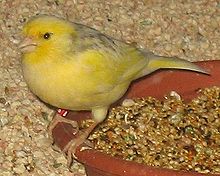
| |
| Domestic canary | |
Domesticated
| |
| Scientific classification | |
| Domain: | Eukaryota |
| Kingdom: | Animalia |
| Phylum: | Chordata |
| Class: | Aves |
| Order: | Passeriformes |
| Family: | Fringillidae |
| Subfamily: | Carduelinae |
| Genus: | Serinus |
| Species: | |
| Subspecies: | S. c. domestica
|
| Trinomial name | |
| Serinus canaria domestica | |
| Synonyms | |
|
Serinus canarius domesticus[3] Linnaeus 1758, I. Geoffroy Saint-Hilaire, 1861[4] | |
The domestic canary, often simply known as the canary (Serinus canaria forma domestica[5]), is a domesticated form of the wild canary, a small songbird in the finch family originating from the Macaronesian Islands (the Azores, Madeira and the Canary Islands).
Canaries were first bred in captivity in the 17th century, having been brought to Europe by Spanish sailors. Monks started breeding them and only sold the males (which sing). This kept the birds in short supply and drove the price up. Eventually, Italians obtained hens and were able to breed the birds. This made them very popular, resulting in many breeds arising, and the birds being bred all over Europe.
The same occurred in England. First the birds were only owned by the rich, but eventually the local citizens started to breed them and, again, they became very popular. Many breeds arose through selective breeding, and they are still very popular today for their voices.
From the 18th up to the 20th centuries, canaries and finches were used in the UK, Canada and the US in the coal mining industry to detect carbon monoxide. In the UK, this practice ceased in 1986.[6]
Typically, the domestic canary is kept as a popular cage and aviary bird. Given proper housing and care, a canary's lifespan ranges from 10 to 15 years.[7]
Etymology
The birds are named after Spain's Canary Islands, which derive their name from the Latin Insula Canaria (after one of the larger islands, Gran Canaria), meaning 'island of dogs', due to its "vast multitudes of dogs of very large size".[8]

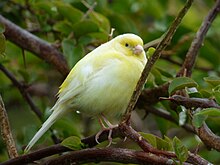
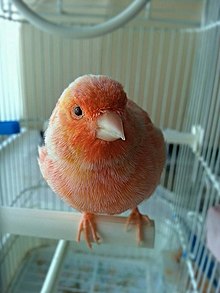

Varieties
Domestic canaries are generally divided into three main groups:
- Colour-bred canaries (bred for their many colour mutations – Ino, Eumo, Satinette, Bronze, Ivory, Onyx, Mosaic, Brown, red factor, Green (Wild Type): darkest black and brown melanin shade in yellow ground birds, Yellow Melanin: mutation showing yellow ground colour with brown and black pigment, Yellow Lipochrome: mutation creating the loss of brown and black pigment, leaving yellow ground colour[9] etc.)
- Type canaries (bred for their shape and conformation – Australian plainhead, Berner, Border, Fife, Gibber Italicus, Gloster, Lancashire, Raza Española, Yorkshire, etc.)
- Song canaries (bred for their unique and specific song patterns – Spanish Timbrado, German Roller (also known as Harz Roller), Waterslager (also known as "Malinois"), American Singer, Russian Singer, Persian Singer).
While wild canaries are a yellowish-green colour, domestic canaries have been selectively bred for a wide variety of colours, such as yellow, orange, brown, black, white, and red (the colour red was introduced to the domestic canary through hybridisation with the red siskin (Spinus cucullatus), a species of South American finch).[10] Evidence of hybridization has also been found between the domestic canary (S. canaria domestica) and the black-chinned siskin (Spinus barbatus) in captivity.[11]
Midway Atoll is home to a colony of feral yellow canaries, descended from pet birds introduced in 1909 by employees of the Commercial Pacific Cable Company.[12] An estimated 500 canaries, which have retained their bright yellow plumage, are resident on Sand Island.[13]
Competitions
Canaries are judged in competitions following the annual molt in the summer.[14] This means that in the Northern Hemisphere the show season generally begins in October or November and runs through December or January. Birds can only be shown by the persons who raised them. A show bird must have a unique band on its leg indicating the year of birth, the band number, and the club to which the breeder belongs. [citation needed]
There are many canary shows all over the world. The world show (C.O.M. - Confederation Ornithologique Mondiale) is held in Europe each year and attracts thousands of breeders. As many as 20,000 birds are brought together for this competition.[citation needed]
Miner's canary
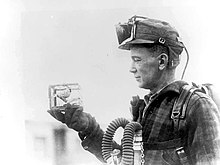
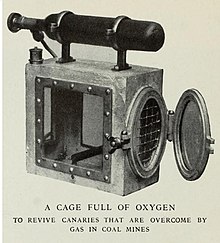
Mice were used as sentinel species for use in detecting carbon monoxide in British coal mining from around 1896,[15] after the idea had been suggested in 1895 by John Scott Haldane.[16] Toxic gases such as carbon monoxide or asphyxiant gases such as methane[17] in the mine would affect small warm-blooded animals before affecting the miners, since their respiratory exchange is more rapid than in humans. A mouse will be affected by carbon monoxide within a few minutes, while a human will have an interval of 20 times as long.[18] Later, canaries were found to be more sensitive and a more effective indicator as they showed more visible signs of distress. Their use in mining is documented from around 1900.[19] The birds were sometimes kept in carriers which had small oxygen bottles attached to revive the birds.[20][21] The use of miners' canaries in British mines was phased out in 1986.[22][23]
The phrase "
Use in research
Canaries have been extensively used in research to study
Fernando Nottebohm, a professor at the Rockefeller University in New York City, detailed the avian brain structures and pathways that are involved in the production of bird song.[25][26]
Canaries are sometimes used to avoid hazardous human testing. Wasicky et al 1949 used them in early testing of
In culture
In organized crime, the canary symbolizes an informant who "sings to the police".[28]
Canaries have been depicted in cartoons from the mid-20th century as being harassed by domestic cats; the most famous cartoon canary is Warner Bros.' "Tweety".
See also
- Atlantic canary (wild canary)
- Australian plainhead
- Harz Roller
- Red factor canary
- Birdcage
- John Scott Haldane
- Warrant canary
- Sentinel species
References
- ^ Index to Organism Names (ION) Archived February 21, 2014, at the Wayback Machine
- ^ Encyclopedia of life
- ^ ION, Index to Organism Names
- ^ The Taxonomicon
- S2CID 205546920.
- ^ Eschener, Kat (December 30, 2016). "The Story of the Real Canary in the Coal Mine". Smithsonian. Retrieved June 11, 2018.
- ^ "Canary Care". Animal World. Retrieved February 27, 2016.
- ^ Pliny the Elder. "Natural History". Archived from the original on April 29, 2019. Retrieved July 25, 2012.
- ^ "Color Canaries: Information and Sound Recordings". Beauty of Birds. September 16, 2021.
- ISBN 978-0-465-00665-6.
- ISSN 2659-2703.
- JSTOR 4071041.
- ^ "Domestic Canary". Friends of Midway Atoll. June 4, 2022. Retrieved June 5, 2023.
- ASIN B0006RK73W.
- PMID 16992351.
- PMID 16992272.
- ISBN 978-1849731218. Retrieved October 25, 2016.
- PMID 16992272.
- S2CID 163033650. Retrieved July 1, 2020.
- ^ Page, Walter Hines; Page, Arthur Wilson (August 1914). "Man And His Machines: Resuscitation Cage For Mine Canaries". The World's Work: A History of Our Time. XXVIII (May to October 1914): 474. Retrieved September 19, 2016.
- ^ "The canary resuscitator | Museum of Science and Industry". March 27, 2018.
- ^ "1986: Coal mine canaries made redundant". BBC News. December 30, 1986. Retrieved May 1, 2010.
- PMID 28107075.
- ^ "'Plutoed' voted US word of year". BBC News. January 8, 2007. Retrieved May 1, 2010.
- ^ "Fernando Nottebohm, Ph.D." The Rockefeller University. Retrieved August 11, 2012.
- ^ "Neurogenesis in Birds". Neurogenesis. Archived from the original on May 25, 2017. Retrieved August 11, 2012.
- ISSN 0066-4170.
- ISBN 9781466554580.
- ^ Heaton, Trevor (June 21, 2014). "How Norwich fell in love with canaries". Eastern Daily Press. Retrieved November 5, 2020.
Further reading
- McDonald, Robirda, Brats in Feathers, Keeping Canaries ISBN 0-9730434-4-X
- Miley-Russell, Marie, The Practical Canary Handbook, A Guide to Breeding and Keeping Canaries. ISBN 1-59113-851-5. Especially useful to American Singer canary owners.
- Linda Hogan, Canary Tales
- GB Walker, Colour, Type, and Song Canaries
- David Alderton, Birds Care, You and your pet bird
- Author unknown, The Canary Handbook, Canaries, Barrons
- Tim Hawcroft, Health Care for Birds
- James Blake, Fife Canaries
External links
- The Canary FAQ
- The Rockefeller University
- Canary Sound on YouTube
